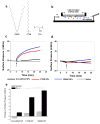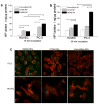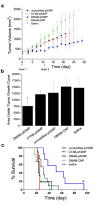Selective biophysical interactions of surface modified nanoparticles with cancer cell lipids improve tumor targeting and gene therapy
- PMID: 23523612
- PMCID: PMC3669664
- DOI: 10.1016/j.canlet.2013.03.011
Selective biophysical interactions of surface modified nanoparticles with cancer cell lipids improve tumor targeting and gene therapy
Abstract
Targeting gene- or drug-loaded nanoparticles (NPs) to tumors and ensuring their intratumoral retention after systemic administration remain key challenges to improving the efficacy of NP-based therapeutics. Here, we investigate a novel targeting approach that exploits changes in lipid metabolism and cell membrane biophysics that occur during malignancy. We hypothesized that modifications to the surface of NPs that preferentially increase their biophysical interaction with the membrane lipids of cancer cells will improve intratumoral retention and in vivo efficacy upon delivery of NPs loaded with a therapeutic gene. We have demonstrated that different surfactants, incorporated onto the NPs' surface, affect the biophysical interactions of NPs with the lipids of cancer cells and normal endothelial cells. NPs surface modified with didodecyldimethylammoniumbromide (DMAB) demonstrated greater interaction with cancer cell lipids, which was 6.7-fold greater than with unmodified NPs and 5.5-fold greater than with endothelial cell lipids. This correlated with increased uptake of DMAB-modified NPs with incubation time by cancer cells compared to other formulations of NPs and to uptake by endothelial cells. Upon systemic injection, DMAB-NPs demonstrated a 4.6-fold increase in tumor accumulation compared to unmodified NPs which also correlated to improved efficacy of p53 gene therapy. Characterization of the biophysical interactions between NPs and lipid membranes of tumors or other diseased tissues/organs may hold promise for engineering targeted delivery of therapeutics.
Copyright © 2013 Elsevier Ireland Ltd. All rights reserved.
Conflict of interest statement
Figures




Similar articles
-
Biophysics of cell membrane lipids in cancer drug resistance: Implications for drug transport and drug delivery with nanoparticles.Adv Drug Deliv Rev. 2013 Nov;65(13-14):1686-98. doi: 10.1016/j.addr.2013.09.004. Epub 2013 Sep 19. Adv Drug Deliv Rev. 2013. PMID: 24055719 Free PMC article. Review.
-
Biomechanics and thermodynamics of nanoparticle interactions with plasma and endosomal membrane lipids in cellular uptake and endosomal escape.Langmuir. 2014 Jul 1;30(25):7522-32. doi: 10.1021/la5015219. Epub 2014 Jun 18. Langmuir. 2014. PMID: 24911361 Free PMC article.
-
Effect of molecular structure of cationic surfactants on biophysical interactions of surfactant-modified nanoparticles with a model membrane and cellular uptake.Langmuir. 2009 Feb 17;25(4):2369-77. doi: 10.1021/la803361y. Langmuir. 2009. PMID: 19161268 Free PMC article.
-
iRGD-modified lipid-polymer hybrid nanoparticles loaded with isoliquiritigenin to enhance anti-breast cancer effect and tumor-targeting ability.Int J Nanomedicine. 2017 Jun 1;12:4147-4162. doi: 10.2147/IJN.S134148. eCollection 2017. Int J Nanomedicine. 2017. PMID: 28615942 Free PMC article.
-
A Review: Surface Engineering of Lipid-Based Drug Delivery Systems.Small. 2024 Oct;20(43):e2401990. doi: 10.1002/smll.202401990. Epub 2024 Jul 14. Small. 2024. PMID: 39004869 Review.
Cited by
-
Advancements in the delivery of epigenetic drugs.Expert Opin Drug Deliv. 2015;12(9):1501-12. doi: 10.1517/17425247.2015.1021678. Epub 2015 Mar 5. Expert Opin Drug Deliv. 2015. PMID: 25739728 Free PMC article. Review.
-
Modulation of the tumor microenvironment for cancer treatment: a biomaterials approach.J Funct Biomater. 2015 Feb 17;6(1):81-103. doi: 10.3390/jfb6010081. J Funct Biomater. 2015. PMID: 25695337 Free PMC article. Review.
-
Biophysics of cell membrane lipids in cancer drug resistance: Implications for drug transport and drug delivery with nanoparticles.Adv Drug Deliv Rev. 2013 Nov;65(13-14):1686-98. doi: 10.1016/j.addr.2013.09.004. Epub 2013 Sep 19. Adv Drug Deliv Rev. 2013. PMID: 24055719 Free PMC article. Review.
-
Inhibition of bone loss with surface-modulated, drug-loaded nanoparticles in an intraosseous model of prostate cancer.J Control Release. 2016 Jun 28;232:83-92. doi: 10.1016/j.jconrel.2016.04.019. Epub 2016 Apr 15. J Control Release. 2016. PMID: 27090164 Free PMC article.
-
Biomechanics and thermodynamics of nanoparticle interactions with plasma and endosomal membrane lipids in cellular uptake and endosomal escape.Langmuir. 2014 Jul 1;30(25):7522-32. doi: 10.1021/la5015219. Epub 2014 Jun 18. Langmuir. 2014. PMID: 24911361 Free PMC article.
References
Publication types
MeSH terms
Substances
Grants and funding
LinkOut - more resources
Full Text Sources
Other Literature Sources
Medical
Research Materials
Miscellaneous

